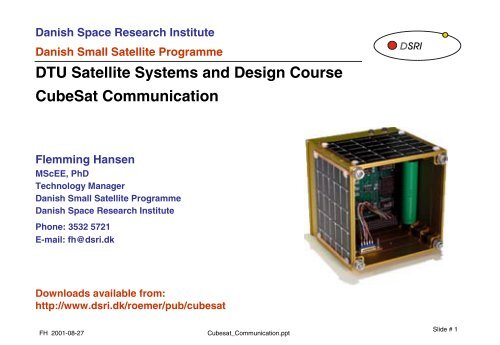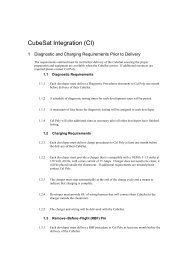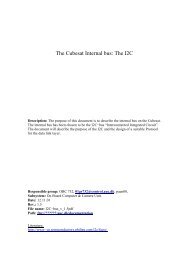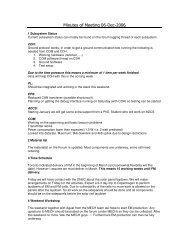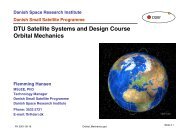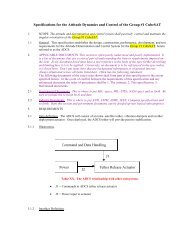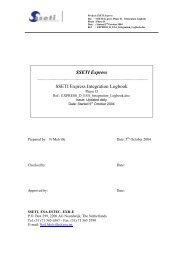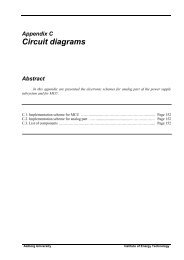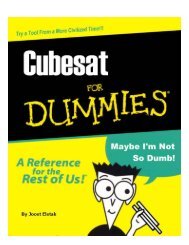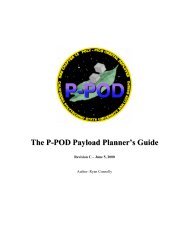DTU Satellite Systems and Design Course CubeSat Communication
DTU Satellite Systems and Design Course CubeSat Communication
DTU Satellite Systems and Design Course CubeSat Communication
Create successful ePaper yourself
Turn your PDF publications into a flip-book with our unique Google optimized e-Paper software.
Danish Space Research Institute<br />
Danish Small <strong>Satellite</strong> Programme<br />
<strong>DTU</strong> <strong>Satellite</strong> <strong>Systems</strong> <strong>and</strong> <strong>Design</strong> <strong>Course</strong><br />
<strong>CubeSat</strong> <strong>Communication</strong><br />
Flemming Hansen<br />
MScEE, PhD<br />
Technology Manager<br />
Danish Small <strong>Satellite</strong> Programme<br />
Danish Space Research Institute<br />
Phone: 3532 5721<br />
E-mail: fh@dsri.dk<br />
Downloads available from:<br />
http://www.dsri.dk/roemer/pub/cubesat<br />
FH 2001-08-27 Cubesat_<strong>Communication</strong>.ppt<br />
Slide # 1
Danish Space Research Institute<br />
Danish Small <strong>Satellite</strong> Programme<br />
<strong>Communication</strong> Fundamentals<br />
Imagine a radio transmitter that emits a power P t equally in al directions (isotropically).<br />
At distance d from the transmitter the transmitted power is distributed equally on the<br />
surface of a sphere with radius d <strong>and</strong> area 4πd 2 .<br />
The flux density in W/m 2 of an isotropically radiating antenna at distance d is therefore:<br />
S<br />
=<br />
Pt 4⋅ π d 2<br />
⋅<br />
FH 2001-08-27 Cubesat_<strong>Communication</strong>.ppt<br />
Slide # 2
Danish Space Research Institute<br />
Danish Small <strong>Satellite</strong> Programme<br />
Transmitting Antenna<br />
Any physical antenna will have some directivity,<br />
i.e. ability to concentrate the emitted power In a<br />
certain direction. Thus, less than the full surface<br />
area of the sphere is “illuminated”, i.e. less than<br />
4π steradian of solid angle.<br />
The ratio between the full 4π steradian spherical<br />
coverage <strong>and</strong> the actually illuminated solid angle<br />
Ω is called the directivity <strong>and</strong> assumes that power<br />
is evenly distributed over Ω <strong>and</strong> zero outside.<br />
The “antenna gain” G t is the ratio of flux density<br />
in a specific direction at distance d <strong>and</strong> the flux<br />
density from the same transmitter using a<br />
hypothetical isotropic antenna.<br />
High-gain<br />
parabolic<br />
antenna<br />
FH 2001-08-27 Cubesat_<strong>Communication</strong>.ppt<br />
Mobile phone with<br />
low-gain antenna<br />
Slide # 3
Danish Space Research Institute<br />
Danish Small <strong>Satellite</strong> Programme<br />
Receiving Antenna<br />
The receiving antenna is assumed to have an “effective area” which “collects” the radio<br />
waves by intercepting the flux of electromagnetic energy. This means that the receiving<br />
antenna collects the total power P r = S⋅A r .<br />
A receiving antenna has an antenna gain in the same way as the transmitting antenna.<br />
The relationship between the antenna gain <strong>and</strong> the effective area is given by:<br />
A r<br />
=<br />
λ 2<br />
4⋅ π<br />
G ⋅ r<br />
λ = c/f is the wavelength of the transmitted signal also known as the carrier<br />
c is the velocity of light (<strong>and</strong> radio waves) in vacuum, c = 2.99792458·10 8 m/s.<br />
f is the frequency of the carrier.<br />
It can be shown theoretically that the transmitting <strong>and</strong> receiving antenna gain is the<br />
same for the same antenna at the same frequency.<br />
FH 2001-08-27 Cubesat_<strong>Communication</strong>.ppt<br />
Slide # 4
Danish Space Research Institute<br />
Danish Small <strong>Satellite</strong> Programme<br />
Parabolic Antenna<br />
The gain of a parabolic antenna very often<br />
used in ground stations <strong>and</strong> sometimes also<br />
on satellites is given by:<br />
G a<br />
:= η ⋅<br />
⎛<br />
⎜<br />
⎝<br />
π ⋅D<br />
λ<br />
η (eta) is the socalled aperture efficiency of<br />
the antenna,<br />
⎞<br />
⎟<br />
⎠<br />
D is the diameter of the dish<br />
λ (lambda) is the wavelength of the carrier<br />
2<br />
For good commercial parabolic antennas the efficiency typically falls in the interval:<br />
0.6 ≤ λ≤ 0.7<br />
FH 2001-08-27 Cubesat_<strong>Communication</strong>.ppt<br />
Slide # 5
Danish Space Research Institute<br />
Danish Small <strong>Satellite</strong> Programme<br />
Link Budget - 1<br />
Fundamentals<br />
The link budget is the foundation for designing any radio link, regardless if is<br />
terrestrial or in space.<br />
The above considerations are gathered into a single equation that expresses the<br />
relationship between the tramsmitter power <strong>and</strong> the power at the output terminals of<br />
the receivning antenna, collecting the power P r = S⋅A r<br />
P r<br />
=<br />
=<br />
Gt ⋅Pt<br />
4⋅ π d 2<br />
⋅<br />
⎛<br />
⎜<br />
⎝<br />
λ<br />
4 ⋅π ⋅d<br />
⋅Ar<br />
⎞<br />
⎟<br />
⎠<br />
2<br />
=<br />
Gt ⋅P<br />
t<br />
4 ⋅ π d 2<br />
⋅<br />
⋅P t ⋅G t ⋅G<br />
r<br />
FH 2001-08-27 Cubesat_<strong>Communication</strong>.ppt<br />
λ 2<br />
⋅ ⋅ Gr =<br />
4 ⋅π<br />
⎛<br />
⎜<br />
⎝<br />
c<br />
4⋅ π ⋅d ⋅f<br />
⎞<br />
⎟<br />
⎠<br />
2<br />
⋅Pt ⋅Gt ⋅Gr<br />
Slide # 6
Danish Space Research Institute<br />
Danish Small <strong>Satellite</strong> Programme<br />
Link Budget - 2<br />
Path Loss<br />
The quantity (λ/4πd) 2 eller (c/4πdf) 2 is also denoted L p -1 <strong>and</strong> ic called the path<br />
attenuation or path loss), i.e.:<br />
L p<br />
=<br />
⎛<br />
⎜<br />
⎝<br />
4⋅π⋅ d⋅f<br />
c<br />
Note that L p is a dimensionless quantity<br />
⎞<br />
⎟<br />
⎠<br />
FH 2001-08-27 Cubesat_<strong>Communication</strong>.ppt<br />
2<br />
The relationship between the received <strong>and</strong> the transmitted powers may now simply be<br />
expressed as<br />
P r /P t = G t ·G r /L p<br />
Slide # 7
Danish Space Research Institute<br />
Danish Small <strong>Satellite</strong> Programme<br />
Link Budget - 3<br />
dB Calculation<br />
Telecommunications engineers like calculations in dB (decibal)<br />
Kommmunikationsingeniører kan godt lide at regne i dB eller decibel.<br />
This is a logarithmic measure expressed fundamentally as the ratio: 10·log(P 1 /P 2 )<br />
where P 1 <strong>and</strong> P 2 are powers.<br />
A power ratio of 10 becomes 10 dB, A power ratio of 2 becomes 3 dB (more accurately<br />
3.01 dB, but in everyday jargon 3 dB).<br />
Every time the power ratio is increased by a factor 10, 10 dB is added.<br />
Reducing by a factor 10, subtracts 10 dB<br />
A doubling adds 3 dB, halving subtracts 3 dB etc.<br />
This implies that multiplication transforms into addition <strong>and</strong> divsion into subtraction,<br />
i.e. the link budget calculations are no more complex than checking the bill from the<br />
super market !!!<br />
FH 2001-08-27 Cubesat_<strong>Communication</strong>.ppt<br />
Slide # 8
Danish Space Research Institute<br />
Danish Small <strong>Satellite</strong> Programme<br />
Link Budget - 4<br />
The Link Budget in dB<br />
Taking the link budget equation <strong>and</strong> subjecting it to the dB-transformation yields:<br />
10⋅log(P r /P t ) = 10⋅log(G t ·G r /L p ) [dB] ⇔<br />
10⋅log(P r ) - 10⋅log(P t ) = 10⋅log(G t ) + 10⋅log(G r ) - 10⋅log(L p ) [dB]<br />
����������� math violation !!!!!<br />
We cannot just take the log of a dimensioned quantity, here Watts, the P’s.<br />
Therefore, we must select a reference power, e.g. 1 Watt <strong>and</strong> divide the P’s by this<br />
quantity, so we don’t violate the math.<br />
Using this trick <strong>and</strong> writing the link budget equation again yields:<br />
10⋅log(P r /1 W) - 10⋅log(P t /1W) = 10⋅log(G t ) + 10⋅log(G r ) - 10⋅log(L p ) [dB]<br />
FH 2001-08-27 Cubesat_<strong>Communication</strong>.ppt<br />
Slide # 9
Danish Space Research Institute<br />
Danish Small <strong>Satellite</strong> Programme<br />
Link Budget - 5<br />
The Link Budget in dB – Skipping the logs<br />
We want to get rid of the 10⋅log(*) in all calculations (as far as possible) <strong>and</strong> switch<br />
now entirely to the ”dB-domain” <strong>and</strong> ”recycle” the letter designations:<br />
P r -P t = G t + G r -L p [dB] ⇔ P r = P t + G t + G r -L p [dB]<br />
To interpret power quantities correctly we need a nomanclature telling us the<br />
reference value used.<br />
Having used 1 W as a reference above we write ”dBW” instead of just dB, when giving<br />
a dB-value for the power<br />
1 W corresponds to 0 dBW, 2 W to 3 dBW, 10 W to 10 dBW etc.<br />
In many cases 1 mW is used as a reference, writing then: “dBm” instead of “dBW”.<br />
Note that dBm og dBW is only about powers. Dimensionless quantities like gain <strong>and</strong><br />
attenuation just uses dB.<br />
FH 2001-08-27 Cubesat_<strong>Communication</strong>.ppt<br />
Slide # 10
Danish Space Research Institute<br />
Danish Small <strong>Satellite</strong> Programme<br />
Link Budget - 6<br />
The Link Budget Concluded<br />
The path attenuation may be transformed into the dB-domain as well: L p<br />
<strong>and</strong> transforms into:<br />
d<br />
Lp = 32.45 + 20 ⋅log⎜<br />
⎟ + 20 ⋅log<br />
1km ⋅<br />
FH 2001-08-27 Cubesat_<strong>Communication</strong>.ppt<br />
⎛<br />
⎝<br />
⎞<br />
⎠<br />
⎛<br />
⎜<br />
⎝<br />
f<br />
1⋅ MHz<br />
⎞<br />
⎟<br />
⎠<br />
=<br />
⎛<br />
⎜<br />
⎝<br />
4⋅π⋅ d⋅f<br />
c<br />
where the 32.45 dB contains the constant 4π/c as well as the powers of 10 coming<br />
from using kilometer instead of meter for the distance <strong>and</strong> Megahertz instead of Hertz<br />
for the carrier frequency. We cannot skip the logs entirely:<br />
d<br />
Pr :=<br />
Pt + Gt + Gr − 32.45−<br />
20⋅log⎜ ⎟ − 20⋅log 1⋅km ⎛<br />
⎝<br />
⎞<br />
⎠<br />
⎛<br />
⎜<br />
⎝<br />
f<br />
1 MHz<br />
⋅<br />
⎞<br />
⎟<br />
⎠<br />
⎞<br />
⎟<br />
⎠<br />
2<br />
Slide # 11
Danish Space Research Institute<br />
Danish Small <strong>Satellite</strong> Programme<br />
Problem # 1<br />
Distance to <strong>Satellite</strong> at Horizon<br />
Assume our Cubesat in a h = 600 km<br />
perfectly circular orbit<br />
Assume that the Earth is perfecly<br />
spherical with a radius Re = 6378 km<br />
Calculate the distance d to the satellite<br />
when it is at the geometrical horizon seen<br />
from the Ground Station<br />
Solution<br />
Using Pythagoras on the triangle Geocenter –<br />
Ground Station - Cubesat yields:<br />
d 2⋅R e⋅<br />
h h 2<br />
:=<br />
+<br />
= 2830.830 km<br />
FH 2001-08-27 Cubesat_<strong>Communication</strong>.ppt<br />
h<br />
Re<br />
Ground<br />
Station<br />
d<br />
Slide # 12<br />
Cubesat
Danish Space Research Institute<br />
Danish Small <strong>Satellite</strong> Programme<br />
Problem # 2<br />
Path Loss<br />
Calculate the path loss for the radio link to<br />
the satellite at horizon using the following<br />
frequencies:<br />
f 1 = 145.8 MHz (typical amateur sat. uplink)<br />
f 2 = 2215 MHz (Ørsted downlink)<br />
Path loss formula:<br />
d<br />
Lp = 32.45 + 20 ⋅log⎜<br />
⎟ + 20 ⋅log<br />
1km ⋅<br />
Solution<br />
L p1 = 144.76 dB<br />
L p1 = 168.40 dB<br />
⎛<br />
⎝<br />
FH 2001-08-27 Cubesat_<strong>Communication</strong>.ppt<br />
⎞<br />
⎠<br />
⎛<br />
⎜<br />
⎝<br />
f<br />
1⋅ MHz<br />
⎞<br />
⎟<br />
⎠<br />
h<br />
Re<br />
Ground<br />
Station<br />
d<br />
Slide # 13<br />
Cubesat
Danish Space Research Institute<br />
Danish Small <strong>Satellite</strong> Programme<br />
Thermal Noise - 1<br />
Everywhere Noise<br />
Any electronic circuit produces noise, thus limiting hoe small a signal we may amplify<br />
<strong>and</strong> detect. Even the most simple electronic component, a resistor, creates noise.<br />
Additionally, noise will be captured by an antenna looking into space from the cosmic<br />
background radiation <strong>and</strong> from the attenuation of the radio waves passing through the<br />
atmosphere caused by water vapour.<br />
Noise calculations again rely on power considerations. Using the theory of<br />
thermodynamics it can be shown that an ideal ohmic resistor in thermal equilibrium at<br />
absolute temperature T will produce an ”available noise power” P n given by<br />
P n = kTW = N 0 ·W where N o = kT<br />
k is Boltzmann's constant k = 1.38062·10 -23 J/K<br />
W is the width of the frequency b<strong>and</strong> containing our signal<br />
N 0 is the noise spectral density, has the unit Watt per Hertz of b<strong>and</strong>width <strong>and</strong> denotes<br />
the noise power available in a 1 Hz b<strong>and</strong>. In many cases N 0 is a constant<br />
FH 2001-08-27 Cubesat_<strong>Communication</strong>.ppt<br />
Slide # 14
Danish Space Research Institute<br />
Danish Small <strong>Satellite</strong> Programme<br />
Thermal Noise - 2<br />
System Noise Temperature<br />
In many cases N 0 is a constant regardless of frequency <strong>and</strong> the noise thus denoted<br />
”white noise” in analogy to white light that contains an equal amount of light at all<br />
wavelengths.<br />
The noise in a radio receiver consists of many different contributions. These are often<br />
all referred to an interface at the antenna terminals including the noise from the<br />
antenna itself.<br />
All noise contributions are espressed as ”noise tempeartures” <strong>and</strong> the sum is denoted<br />
the ”system noise temperature” T sys or just T for short.<br />
The total noise power at the receiver input is therefore:<br />
P n = P n,sys = kT sys·W = kTW<br />
FH 2001-08-27 Cubesat_<strong>Communication</strong>.ppt<br />
Slide # 15
Danish Space Research Institute<br />
Danish Small <strong>Satellite</strong> Programme<br />
Thermal Noise - 3<br />
Signal to Noise Ratio<br />
The Signal-to-Noise Ratio – SNR is the ratio between the power of the information<br />
carrying signal <strong>and</strong> the power of the unwanted noise (in the same b<strong>and</strong>width):<br />
ℜ = P s /P n<br />
where P s is the signal power <strong>and</strong> P n is the noise power.<br />
In the dB-domain this comes out as:<br />
SNR = P s -P n<br />
Using the link budget equation: P r = P t + G t + G r -L p [dB] prevoiusly derived, we get:<br />
SNR = P t + G t + G r -L p -P n<br />
The value of the SNR is the determining factor whether we can extract useful<br />
information from the received radio signal or not.<br />
FH 2001-08-27 Cubesat_<strong>Communication</strong>.ppt<br />
Slide # 16
Danish Space Research Institute<br />
Danish Small <strong>Satellite</strong> Programme<br />
Digital <strong>Communication</strong> - 1<br />
Modulation<br />
A radio signal, a modulated carrier is a sinusoidal alternating voltage, normally<br />
expressed using cosine:<br />
S(t) = A⋅cos(ω⋅ ω⋅ ω⋅t ω⋅ + ϕ) = A⋅cos(2⋅π⋅ ⋅π⋅ ⋅π⋅f⋅t ⋅π⋅ + ϕ)<br />
where t er time, A signal amplitude, ω (omega) the angular frequency of the carrier<br />
ω = 2⋅π⋅ ⋅π⋅ ⋅π⋅f, ⋅π⋅ where f is the carrier frequency<br />
ϕ (phi) is the phase 0° ≤ϕ < 360° or 0 ≤ ϕ < 2π radian.<br />
The process of transferring information to a carrier is denoted modulation <strong>and</strong> involves<br />
varying one of the three parameters<br />
A amplitude modulation - AM<br />
ω frequency modulation - FM<br />
ϕ phase modulation - PM.<br />
The most common format for space communications is phase modulation – PM.<br />
FH 2001-08-27 Cubesat_<strong>Communication</strong>.ppt<br />
Slide # 17
Danish Space Research Institute<br />
Danish Small <strong>Satellite</strong> Programme<br />
Digital <strong>Communication</strong> - 2<br />
Digital Modulation<br />
If we imagine our digital information as a bit stream of speed B bits per second, the<br />
duration of each bit is<br />
τ = 1/B [seconds]<br />
Phase Modulation - PM<br />
Let the phase 0° represent binary 0 og phasen 180° represent binary 1.<br />
Hold the phase of the carrier for τ seconds, after which we take the next bit period<br />
This format is denoted “Phase Shift Keying – PSK” or BPSK, where B means Binary<br />
Using simple arguments it is easy to realize that PSK using phases 0° <strong>and</strong> 180° is<br />
identical to amplitude modulation using the amplitdes +1 <strong>and</strong> –1. Try it yourself:<br />
S(t) = A⋅cos(ω⋅ ω⋅ ω⋅t ω⋅ + ϕ) = A⋅cos(2⋅π⋅ ⋅π⋅ ⋅π⋅f⋅t ⋅π⋅ + ϕ)<br />
FH 2001-08-27 Cubesat_<strong>Communication</strong>.ppt<br />
Slide # 18
Danish Space Research Institute<br />
Danish Small <strong>Satellite</strong> Programme<br />
Digital <strong>Communication</strong> - 3<br />
The Link Budget <strong>and</strong> Signal-to-Noise Ratio Revisited<br />
We may now introduce the universal Signal-to-Noise Ratio for digital communication:<br />
E b /N 0 = P r ·τ/N 0 = P r /(B⋅N 0 ) = P r /(B⋅k⋅T)<br />
This is denoted “E-b-over-N-zero” or ”Ebno” for short<br />
It expresses the energy per bit divided by the noise spectral density<br />
Examination of the Parameters Used<br />
Energy per bit at the receiver input is the received power P r times the bit period τ<br />
(Watt⋅seconds = Joule/sec ⋅ sec = Joule).<br />
The denominator B⋅N 0 may be interpreted as the noise power in a b<strong>and</strong>width B<br />
corresponding to the bit rate in Hertz.<br />
FH 2001-08-27 Cubesat_<strong>Communication</strong>.ppt<br />
Slide # 19
Danish Space Research Institute<br />
Danish Small <strong>Satellite</strong> Programme<br />
Digital <strong>Communication</strong> - 4<br />
To proceed, we rewrite the “Ebno” equation in the dB-domain:<br />
or<br />
10⋅log(E b /N 0 ) = 10⋅log(P r ) - 10⋅log(B/1 Hz) - 10⋅log(k/1 J/K) - 10⋅log(T/1 K) [dB]<br />
E b /N 0 = P r - 10⋅log(B/1 Hz) - 10⋅log(k/1 J/K) - 10⋅log(T/1 K) [dB]<br />
where E b /N 0 is now expressed in dB <strong>and</strong> P r in dBW or dBm. As usual proper reference<br />
values must be used to make the arguments to the logs dimensionless.<br />
We complete ignore the inconsistency of writing E b /N 0 in the dB expression. E b /N 0 is<br />
now a symbol, not a calculation.<br />
Combining this with the link budget equation P r = P t + G t + G r -L p [dB], we get:<br />
E b /N 0 = (P t + G t ) + G r - L p - 10⋅log(B/1 Hz) - 10⋅log(k/1 J/K) - 10⋅log(T/1 K) [dB]<br />
The quantity P t + G t is denoted EIRP (Equivalent Isotropically Radiated Power):<br />
E b /N 0 = EIRP + G r - L p - 10⋅log(B/1 Hz) - 10⋅log(k/1 J/K) - 10⋅log(T/1 K) [dB]<br />
FH 2001-08-27 Cubesat_<strong>Communication</strong>.ppt<br />
Slide # 20
Danish Space Research Institute<br />
Danish Small <strong>Satellite</strong> Programme<br />
Digital <strong>Communication</strong> - 5<br />
We now introduce the path loss equation:<br />
d<br />
Lp =<br />
32.45 + 20 ⋅log⎜<br />
⎟ + 20 ⋅log<br />
1km ⋅<br />
into the Ebno equation <strong>and</strong> get:<br />
E b /N 0 = EIRP + G r – 32.45 - 20⋅log(d/1 km) - 20⋅log(f/1 MHz)<br />
- 10⋅log(B/1 Hz) - 10⋅log(k/1 J/K) - 10⋅log(T/1 K) [dB]<br />
The dB-value of Boltzmann’s constant is calculated to 10⋅log(k/1 J/K) = -228.60 dB <strong>and</strong><br />
introduced into the equation. In addition the equation is restructured a little:<br />
E b /N 0 = EIRP + (G r - 10⋅log(T/1 K)) – 32.45 + 228.60<br />
- 20⋅log(d/1 km) - 20⋅log(f/1 MHz) - 10⋅log(B/1 Hz) [dB]<br />
FH 2001-08-27 Cubesat_<strong>Communication</strong>.ppt<br />
⎛<br />
⎝<br />
⎞<br />
⎠<br />
⎛<br />
⎜<br />
⎝<br />
f<br />
1⋅ MHz<br />
⎞<br />
⎟<br />
⎠<br />
/continued...<br />
Slide # 21
Danish Space Research Institute<br />
Danish Small <strong>Satellite</strong> Programme<br />
Digital <strong>Communication</strong> - 6<br />
Further restructuring of the equation yields:<br />
or<br />
E b /N 0 = EIRP + G/T – 32.45 + 228.60<br />
- 20⋅log(d/1 km) - 20⋅log(f/1 MHz) - 10⋅log(B/1 Hz)<br />
E b /N 0 = EIRP + G/T + 196.15 - 20⋅log(d/1 km) - 20⋅log(f/1 MHz) - 10⋅log(B/1 Hz) [dB]<br />
This is the magic link budget equation<br />
EIRP = P t + G t is the “Equivalent Isotropically Radiated Power” or the power required by<br />
the transmitter output stage if the antenna radiated equally in all directions<br />
(isotropically). The advantage of using EIRP is that you may trade antenna gain for<br />
transmitter output power for a given EIRP requirement.<br />
G/T = G r - 10⋅log(T/1 K) [dB/K], pronounced G-over-T, is a measure of the quality factor or<br />
performance of the receiver. G/T allows the link designer to trade receiving antenna gain<br />
for system noise temperature with a given G/T requirement. Again there is an<br />
inconsistency of nomenclature. G/T is a symbol, not a calculation.<br />
FH 2001-08-27 Cubesat_<strong>Communication</strong>.ppt<br />
Slide # 22
Danish Space Research Institute<br />
Danish Small <strong>Satellite</strong> Programme<br />
Digital <strong>Communication</strong> - 7<br />
Bit Error Probability<br />
To be able to assess the quality of our radio link<br />
a relation between E b /N 0 <strong>and</strong> the error rate of the<br />
received bits must be established. The bit error<br />
rate must be low, but at a reasonable cost only.<br />
The graph marked PSK is a plot of the function<br />
P e<br />
:=<br />
1<br />
2 erfc ⋅<br />
⎛<br />
⎜<br />
⎜<br />
⎝<br />
E b<br />
N o<br />
where Pe is the bit error probability <strong>and</strong> erfc() is<br />
the error function complement, a st<strong>and</strong>ard<br />
function in probability theory.<br />
The curve marked VD is the bit error probability<br />
using forward error correction (FEC) encoding.<br />
FH 2001-08-27 Cubesat_<strong>Communication</strong>.ppt<br />
⎞<br />
⎠<br />
Slide # 23
Danish Space Research Institute<br />
Danish Small <strong>Satellite</strong> Programme<br />
Problem # 3<br />
Cubesat Downlink<br />
Assume that our Cubesat in a 600 km circular orbit<br />
has a 1 W (= 0 dBW) transmitter <strong>and</strong> radiates this<br />
power towards the ground station using an<br />
antenna with 0 dB gain in the direction of the<br />
ground station <strong>and</strong> the satellite at the horizon.<br />
Carrier frequency: f = 2215 MHz (Ørsted frequency)<br />
Distance to satellite: 2830.830 km at horizon<br />
Bit rate: 256 kbit/s<br />
G/T: 5 dB/K (Ørsted ground station at DMI)<br />
Magic link budget equation:<br />
E b /N 0 = EIRP + G/T + 196.15 - 20⋅log(d/1 km)<br />
- 20⋅log(f/1 MHz) - 10⋅log(B/1 Hz) [dB]<br />
Calculate E b /N 0 <strong>and</strong> read P e off the graph<br />
FH 2001-08-27 Cubesat_<strong>Communication</strong>.ppt<br />
Slide # 24
Danish Space Research Institute<br />
Danish Small <strong>Satellite</strong> Programme<br />
Problem # 3 continued<br />
Solution<br />
EIRP = 0 + 0 = 0 dBW<br />
E b /N 0<br />
E b /N 0<br />
= EIRP + G/T + 196.15 - 20⋅log(d/1 km) - 20⋅log(f/1 MHz) - 10⋅log(B/1 Hz) [dB]<br />
= 0 + 5 + 196.15 – 20·log(2830.830) - 20·log(2215) - 10·log(256000) [dB]<br />
= 0 + 5 + 196.15 – 69.04 – 66.91 – 54.08 [dB]<br />
= 11.12 dB<br />
P e = 1.813·10 -7 without forward error correction encoding<br />
Ørsted actually does a lot better as a very efficient FEC encoding is used.<br />
FH 2001-08-27 Cubesat_<strong>Communication</strong>.ppt<br />
Slide # 25


